Brigadier General
Paul Warfield Tibbets, Jr.,
U.S.A.F. |
|
(1915-2007) |
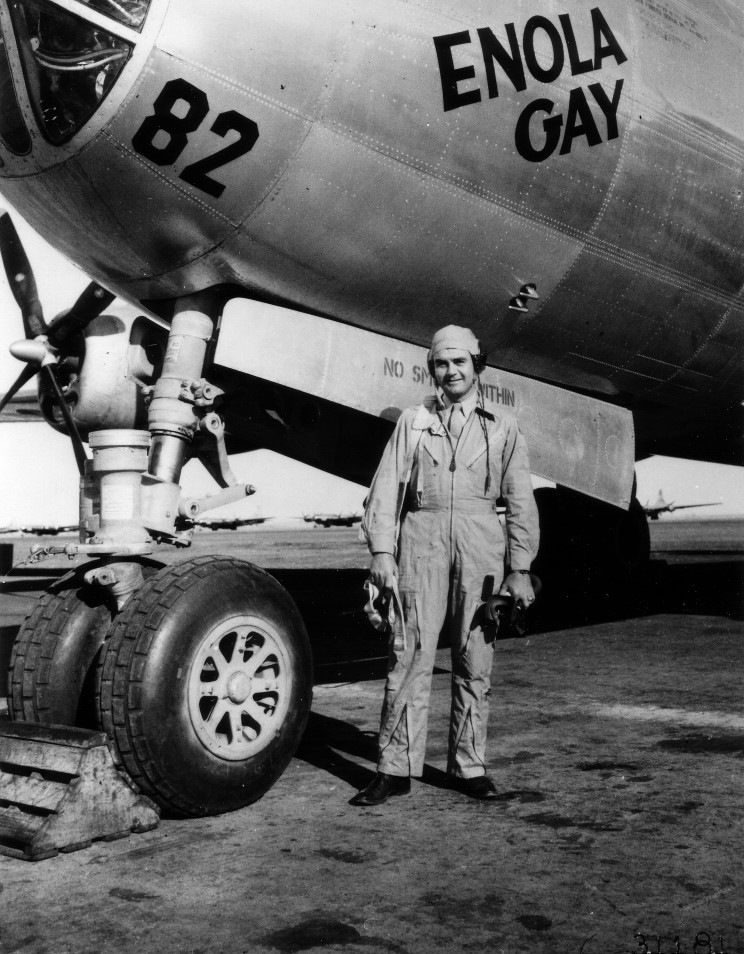 |
Col. Paul W. Tibbets, Jr. standing next to the B-29 Enola Gay at Roswell Army Airfield, Roswell, New Mexico. This photo was taken after the Hiroshima mission. |
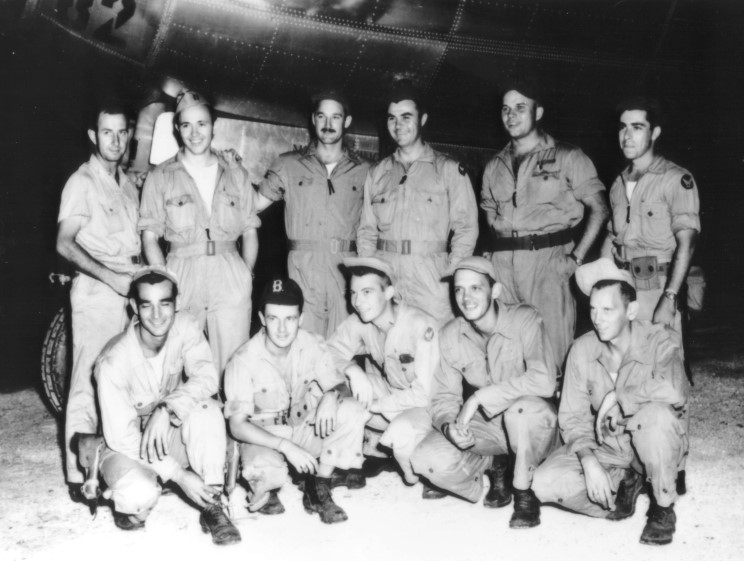 |
The flight and ground crews of the Enola Gay seen on Tinian Island. Col. Tibbets is seen in the center of the top row. |
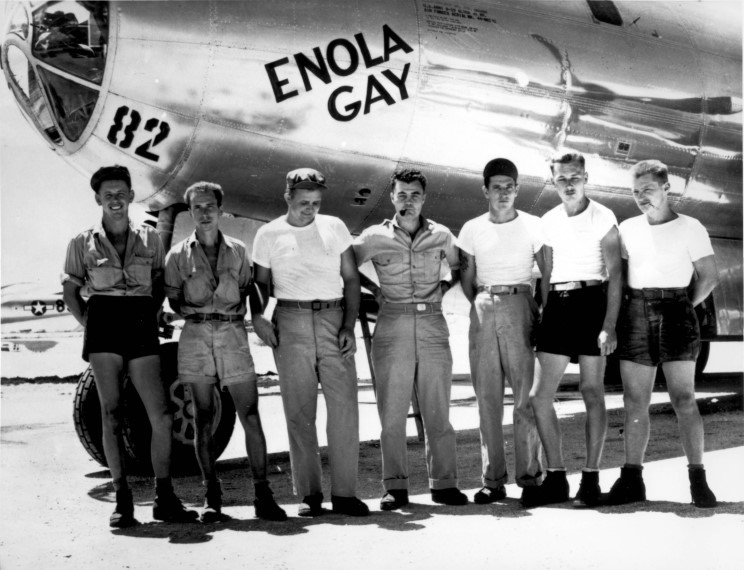 |
Col. Paul W. Tibbets, Jr. poses with members of the Enola Gay's ground crew on Tinian Island. |
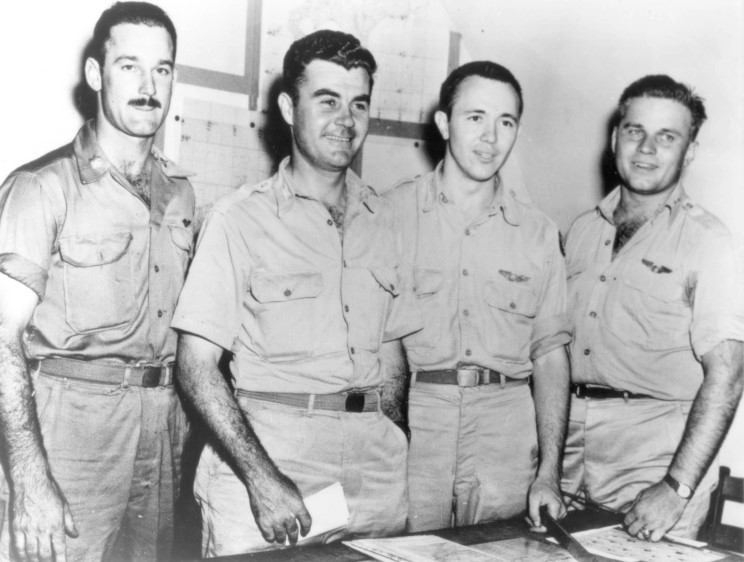 |
Some of the members of the flight crew of the Enola Gay during the Hiroshima mission. From left to right: Major Thomas W. Ferebee (bombardier), Col. Paul W. Tibbets, Jr. (pilot), Capt. Theodore van Kirk (navigator) and Capt. Robert A. Lewis (co-pilot). |
 |
The Enola Gay returning to Tinian following the Hiroshima mission.
|
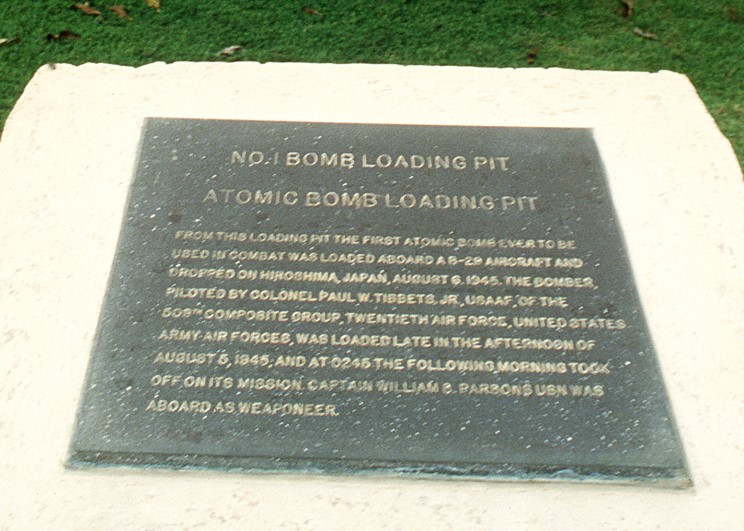 |
The plaque on Tinian memorializes the spot where the atomic bomb was loaded on to the Enola Gay. |
Paul Warfield Tibbets, Jr. (February 23, 1915 - November 1, 2007) was a brigadier general in the United States Air Force, best known for being the pilot of the first aircraft to drop an atomic bomb. Tibbets was born in Quincy , Illinois, and was the son of Paul Warfield Tibbets and Enola Gay Tibbets (nee Haggard). Although born in Illinois, Tibbets was raised in Cedar Rapids, Iowa, where his father was a confections wholesaler. The family was listed there in the 1920 U.S. Federal Population Census. The 1930 Census indicates his family had moved and was living in Des Moines, Iowa at the time. Sometime later, the family moved to Florida. He attended the University of Florida in Gainesville and was an initiated member of the Epsilon Zeta Chapter of Sigma Nu Fraternity in 1934. On February 25, 1937, he enlisted as a flying cadet in the Army Air Corps at Fort Thomas, Kentucky. He was commissioned a second lieutenant in 1938 and received his wings at Kelly Field, Texas. Tibbets was named commanding officer of the 340th Bomb Squadron, 97th Heavy Bomb Group flying B-17 Flying Fortresses in March, 1942. Based at RAF Polebrook, he piloted the lead bomber on the first Eighth Air Force bombing mission in Europe on August 17, 1942, and later flew combat missions in the Mediterranean Theater of Operations until returning to the U.S. to test fly B-29 Superfortresses. "By reputation", Tibbets was "the best flier in the Army Air Force". One of those who confirmed this reputation was Dwight Eisenhower, for whom Tibbets served as a personal pilot at times during the war. In September 1944 he was selected to command the project at Wendover Army Air Field, Utah, that became the 509th Composite Group, in connection with the Manhattan Project's Project Alberta. On August 5, 1945, Colonel Paul Tibbets formally named B-29 serial number 44-86292 Enola Gay after his mother (she was named after the heroine, Enola, of a novel her father had liked). On August 6, 1945, the Enola Gay departed Tinian Island in the Marianas with Tibbets at the controls at 2:45 a.m. for Hiroshima, Japan. The atomic bomb, code named Little Boy, was dropped over Hiroshima at 8:15 a.m. local time, killing about 140,000 Japanese, with many more dying later. The film Above and Beyond (1952) depicted the World War II events involving Tibbets, with Robert Taylor starring as Tibbets and Eleanor Parker as his first wife, Lucy. In 1980, a made-for-television movie aired, again telling a possibly more fictionalized version of the story of Tibbets and his men, with Patrick Duffy (Bobby Ewing from " Dallas ") playing the part of Tibbets and Kim Darby as Lucy. The film was called, Enola Gay: The Men, the Mission, the Atomic Bomb. Tibbets was also portrayed in the films Day One and The Beginning or the End. Tibbets married his wife, Andrea, in about 1953 or 1954. In 1959, he was promoted to Brigadier General. He retired from the U.S. Air Force on August 31, 1966. In the 1960s, Tibbets was posted as military attaché in India, but this posting was rescinded after protests. After retirement, he worked for Executive Jet Aviation, a Columbus, Ohio-based air taxi company, and was president from 1976 until he retired in 1987. In 1976, he was criticized for re-enacting the bombing at an air show in Texas. Tibbets said it was not meant as an insult, but the U.S. government formally apologized when Japan complained. In 1995, he called a planned 50th anniversary exhibition of the Enola Gay at the Smithsonian Institution, putting the bombing in context of the suffering it caused, a "damn big insult". An interview of Paul Tibbets can be seen in the 1982 movie Atomic Cafe. He was also interviewed in the 1970s British documentary series The World at War. His grandson Lt. Col. Paul W. Tibbets, IV, as of 2006 is commander of the 393rd Bomb Squadron, flying the B-2 Spirit. The 393rd is one of two operational squadrons under the same unit his grandfather commanded, the 509th Bomb Wing. Tibbets was interviewed extensively by Mike Harden of the Columbus (Ohio) Dispatch, and profiles appeared in the newspaper on anniversaries of the first dropping of an atomic bomb. Tibbets expressed no regret regarding the decision to drop the bomb. In a 1975 interview he said: "I'm proud that I was able to start with nothing, plan it and have it work as perfectly as it did... I sleep clearly every night". In March 2005, he stated "If you give me the same circumstances, hell yeah, I'd do it again." Tibbets died in his Columbus, Ohio home on November 1, 2007 at age 92. He had suffered small strokes and heart failure in his final years and had been in hospice care. Tibbets laid down in his will that there should be no funeral service after his death and no tombstone for fear this might lead to demonstrations at his grave. He wanted to prevent that his grave turn into a pilgrim site for possible opponents to the dropping of atomic bombs. Tibbets wanted to be cremated, and have his ashes dispersed into the waters of the English Channel. |
(Text courtesy of Wikipedia) |
Page published Nov. 1, 2007 |